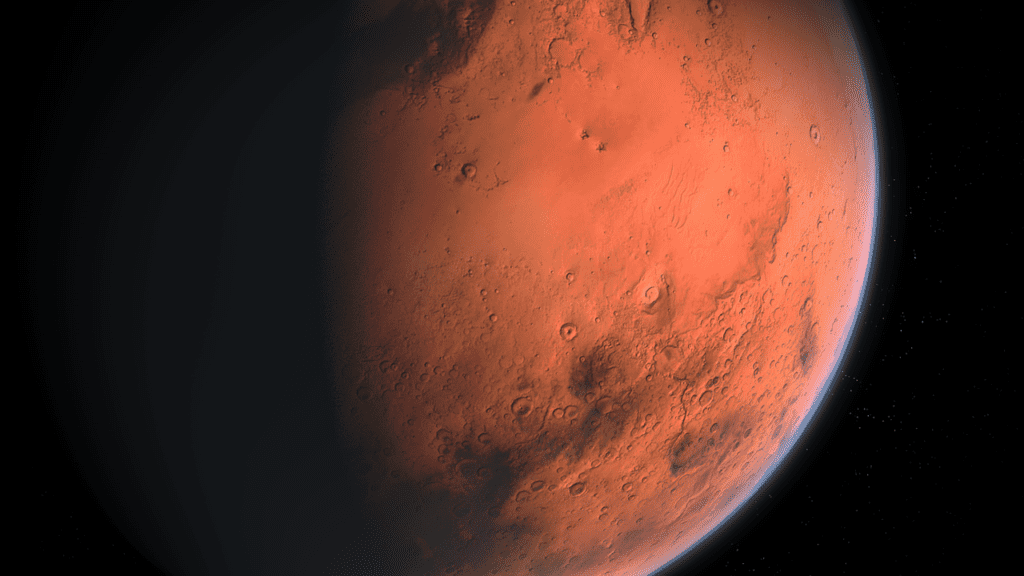Tread carefully, there be microfossils here! Or, at least, there might be — so NASA is sending a rover to Mars to find out.

The Mars 2020 rover will likely go fossil-finding on Mars, after NASA researchers have identified Jezero Crater (where the rover will land on Feb. 18, 2021) as a promising site to look for ancient, alien life. The crater used to be a lake some 3.5 billion years ago, and its inner rim is lined with carbonate rocks. On Earth, carbonate rocks are a very rich source of fossils including seashells and coral.
Fossilized alien life — maybe
“CRISM [Compact Reconnaissance Imaging Spectrometer for Mars instrument] spotted carbonates here years ago, but we only recently noticed how concentrated they are right where a lakeshore would be,” said the paper’s lead author, Briony Horgan of Purdue University in West Lafayette, Indiana.
“We’re going to encounter carbonate deposits in many locations throughout the mission, but the bathtub ring will be one of the most exciting places to visit.”
A new paper published by members of NASA’s Mars 2020 team highlights the mineral deposits along Jezero’s inner rim as a possible resting place of life long-lost on the red planet. Carbonate rocks are predominantly formed by biological activity here on Earth, and the paper suggests Jezero’s might have been built by ancient microbes living along the alien shoreline during a time when both sunlight and water were plentiful on Mars.
It’s possible that the rocks in Jezero are similar to the stromatolites of Earth, a type of carbonate rock formed by the growth of layer upon layer of cyanobacteria. These are some of the best records we have of ancient microorganisms on our planet, and the possibility of finding them on Mars is understandably getting everyone at NASA very excited. The 45-kilometer wide crater was once a sprawling river delta, the team explains. The ‘bathtub ring’ Horgan mentioned are carbonate rocks that formed on the delta’s edges.
The Mars 2020 rover is definitely well-equipped for the task. As the mission focuses on the study of alien life, the rover packs a suite of specialized scientific instruments. It will help search for ancient microbial life on Mars by drilling down, taking rock core samples, and depositing them on the surface — these tubes will be retrieved by later missions.
Even if we don’t find fossils, carbonate rocks can tell us how Mars shifted from an Earth-like place to the desolate, rusty wasteland of today. These minerals form from the interaction between water and carbon dioxide gas in the atmosphere so, in effect, they record changes in these two elements over time. By analyzing the rocks’ properties, and how they changed over time, the team hopes to recreate the history of Mars. We have no guarantee yet that these carbonates were formed in a lake (they could have formed before-hand), but until we get a rover up there, we can’t know for sure.
The team hopes to explore the crater floor and the ancient delta within two years. The rover will likely reach the crater’s rim and its carbonates near the end of that period.
“The possibility that the ‘marginal carbonates’ formed in the lake environment was one of the most exciting features that led us to our Jezero landing site. Carbonate chemistry on an ancient lakeshore is a fantastic recipe for preserving records of ancient life and climate,” said Mars 2020 Deputy Project Scientist Ken Williford of NASA’s Jet Propulsion Laboratory in Pasadena, California. “We’re eager to get to the surface and discover how these carbonates formed.”
The Mars 2020 mission is part of a larger program including Moon missions and early steps towards putting a human on Mars. NASA plans to establish sustained human presence on the Moon by 2028 with the Artemis mission.
The paper “The mineral diversity of Jezero crater: Evidence for possible lacustrine carbonates on Mars” has been published in the journal Icarus.


